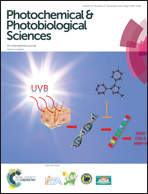Novel hetarylazo dyes containing tetrazole and hydroquinoline moieties: spectral characteristics, solvatochromism and photochemistry†
Abstract
Novel hetarylazo dyes containing tetrazole and tetra- or dihydroquinoline moieties were synthesized and their spectral properties in solvents of different polarities and H-bonding abilities were examined. The dyes exhibit solvatochromism dramatically depending on the proton accepting ability of solvents: (DMSO > H2O > MeOH > ACN > CH2Cl2) and the dye concentration. Upon dilution the absorption maximum of the visible band shows a blue shift and the absorption coefficient of the maximum decreases. This was accounted for by complex formation either between the dye molecules or between the dye and solvent molecules. The H-bond with partial proton transfer is formed between the acidic NH group of the tetrazole moiety of a dye molecule and the basic NH group of the hydroquinoline moiety of the other dye molecule or with a solvent with proton accepting ability. Upon dilution the equilibrium shifts to the complex with a solvent. The coexistence of several forms of the dye molecules with different absorption spectra was demonstrated in pulse photolysis upon excitation by light with different wavelengths. Three forms of cis-isomers were registered. The photogenerated cis-isomers decay with lifetimes from 200 μs to 5 ms. The fast cis–trans dark isomerization determines the photostability of the dyes.


 Please wait while we load your content...
Please wait while we load your content...